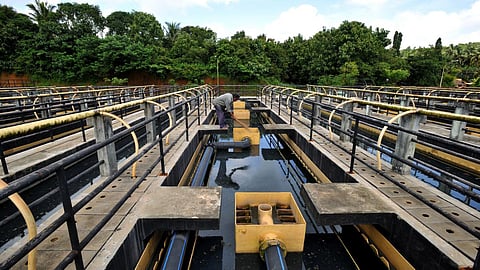
- Topics
- Feature
- Opportunities & Events
- About
- Hindi Portal
- Data
- Topics
- Feature
- Opportunities & Events
- About
- Hindi Portal
- Data

The market value of treated wastewater in India will be INR 830 million in 2025 and INR 1.9 billion in 2050 if we have the mechanism to sell it to select sectors, according to an independent study by the Council on Energy, Environment and Water (CEEW). The study, Reuse of Treated Wastewater in India highlights that India will produce over 35,000 million cubic meters of wastewater by 2050, and if treated, this water can irrigate 26 times the area of New Delhi.
Water security is an imminent issue in India. As per CEEW analysis using Central Water Commission estimates, 11 out of the 15 major river basins in India will experience water stress by 2025. Hence, it is essential to explore alternative sources of water to address the demand-supply gap.
India treats only 28% of the total sewage it generates per day from the urban centres (CPCB 2021). Out of the 72,368 million litres per day (MLD) of sewage produced in urban centres, the actual treatment is of only 20,236 MLD (CPCB 2021). Class I cities (those whose population is above 1,00,000) and class II cities (with population of 50,000– 99,999), which represent a major share (72%) of the total urban population, produce an estimated 38,254 MLD of sewage, of which only 30% is actually treated (CPCB 2021).
The untreated wastewater is then discharged into freshwater bodies, such as rivers. Given the exponential amount of wastewater generated in the country, India has immense potential to meet the growing water demand across different sectors and improve the water environment with proper management. Through this study, CEEW intends to estimate the market potential for the reuse of treated wastewater (domestic sewage) at the national scale and make recommendations to strengthen the existing governance on reuse.
“At 1,486 cubic meters of water available per capita per annum, India is a water-stressed country. Promoting the reuse of treated wastewater will reduce pressure on freshwater resources and lead to several benefits and positive externalities. There is a huge market potential for reusing it for irrigation alone provided financially viable models are developed to scale up wastewater treatment and reuse,” says Nitin Bassi, Programme Lead, CEEW.
Around 6,000 metric tonnes (MT) of nutrients could have been recovered from the available treated wastewater in 2021, generating savings of INR 50 million. As per our estimates, the nutrients supplied by currently available treated wastewater (for irrigation use in 2021) amount to more than 6,000 tonnes. Further, considering the market value of the nutrient load, we estimate that the total savings from the reduction in fertiliser use through irrigation using treated wastewater would have been more than INR 50 million.
The study undertook this analysis to understand the comprehensiveness of the treated wastewater reuse policies of Indian states and to determine whether they will be able to realise the market potential of the treated wastewater in the future. The CEEW study found that only 10 states in India have a treated wastewater reuse policy. Of these state policies, most do not have incentives for end users of the wastewater, or define quality standards for the specific purpose of reuse.
“Provisions for treated wastewater quality standards in state policies are limited to safe discharge standards. All Indian states must define reuse-specific wastewater treatment standards for safe reuse across different sectors. Finally, states should develop effective outreach plans to build public confidence and nudge behaviour for the successful implementation of wastewater reuse projects,” Saiba Gupta, Research Analyst, CEEW.
Only a few states identify the positive externalities associated with the treatment of wastewater and reuse.
These include improvement in the water quality of receiving natural water bodies and the associated public health impacts.
The criteria for the selection of appropriate business models is not defined.
Almost all state policies call for public–private partnerships (PPP) for developing treated wastewater reuse projects. However, they do not include the criteria for the selection of appropriate business models for effective implementation. Though the national framework on the safe reuse of treated water that was launched in January 2023 provides guidelines on some of the identified gaps, the state policies were launched much before and need revision to address these gaps comprehensively.
Read the full study here.